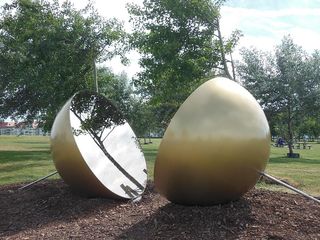Creativity
Team-to-Team Innovation Learning in Science
Changing cultures and expectations to advance creative scientific progress.
Posted March 29, 2020

Many of us may have read the somewhat disheartening news about the frequency with which important new and breakthrough findings in the social and life sciences have turned out to be difficult for other researchers to replicate. It's even been given its own moniker, "the replication crisis."
A host of different factors may contribute to failures to replicate, but here let's take a look at a novel approach to the challenge of replicating important complex and technologically advanced discoveries in biology.
Something new, something old, something borrowed...
At first blush, the new approach seems remarkably simple. The new approach is to require the primary research team to be "shadowed" or "mirrored" by a second smaller team of independent experts. The primary funded biological research group (for shorthand, let's call them Team A) that is seeking to make cutting-edge discoveries is to be closely followed by the independent group of experts (Team B). Team B is explicitly tasked with the primary goal of replicating the findings of Team A.
But there is a key and important twist: Rather than waiting many months or years before Team A makes and publishes its discoveries and methods, Team A must—from the very beginning—share its innermost thoughts and workings with Team B.
No longer can Team A quietly work in secret, jealously shielding its latest experimental or conceptual breakthroughs from all possible competitors. Instead, from the very outset of launching the research project and throughout the time of the project, Team A must openly share all of its ongoing findings and developing methods with its mirror team, Team B. And that's not all. Team B is given all of the money, equipment, samples, and other resources it needs to be able to go off, on its own, and independently replicate what Team A has found.
So now, Team A, for example, invites the mirror team members to come and closely watch them while they work through their protocols. Team A shares with Team B its minor triumphs, its mini-successes, and its day-to-day failures or missteps. Sometimes Team A also videotapes themselves as they go through a complicated protocol. Step-by-step in the video, they show Team B what they are doing, describing in painstaking detail each minor step or turn in the procedure.
But wait! Why adopt what looks like such a "copycat" approach? Isn't it wasteful? What's to be gained from such extensive, intensive—and expensive—mirroring of one research team's efforts by a second research team?
Why adopt a mirroring approach?
This innovative mirroring approach helps to tackle many of the pesky, persistent, and problematic obstacles standing in the way of one research lab being enabled to fully and faithfully replicate the complex biological and technological research methods and procedures of another lab.
Even when we earnestly try to communicate exactly what we're doing, we may make assumptions or leave out important steps so that we don't clearly communicate with each other. Sometimes we're not even aware that small details could make a large difference. For example, in one case, the reduced viability of an organism in a shadow lab was due to a difference of 2 degrees Celsius in the ambient lab temperature, whereas the Team A lab had a more constantly controlled temperature. In other cases, how vigorously cells were washed or using a slightly different size of a pipette tip led to unpredictable changes in the results for Team A versus Team B.
The primary-plus-mirror-teams arrangement has now been in progress for over three years. Both Team A and Team B have been funded by the Biological Technologies Office of DARPA—the US Defense Advanced Research Projects Agency. The team-to-team innovation tracking arrangement has uncovered many "how-to" lessons that can benefit nearly all scientific and technological teams in their ongoing creative search and experimentation.
Yet, although the Team-A-plus-Team-B structure is quite new to complex biological research, it is not new to more traditional forms of engineering or electronics. Here a process of "independent validation and verification" has been part and parcel of research for decades.
Take NASA, for example. A separate "independent validation and verification" facility has long been an integral part of NASA—with more than 300 employees specifically tasked with independent testing and giving a "thumbs-up" (or thumbs-down) to the computer code and components for satellites developed by other NASA teams. The same is true for teams working in electronics. But, until recently, it has not been true for research in complex biological and biological-engineering sciences.
Thinking together in physical space
Why is it sometimes important for teams or individuals to actually meet in the same physical space or to watch and hear the step-by-step videotapes of a lab procedure?
Some clues can be found in an earlier integrative review—fittingly titled "distance matters"—by two researchers who, for decades, researched the thinking, working, and social processes of teams "co-located" in space and time versus teams connected by various modes of technology. Based on their findings, the researchers pointed to several advantages of individuals being together in the same space or being co-located as they work on a complex problem. To highlight three of these advantages:
1. Rapid feedback: If someone has misunderstood or misinterpreted something or glossed over an important detail, if they are physically together in the same place, Team B could "pipe up" to ask for elaboration or a re-statement of the points, right then and there.
2. Multiple communication channels: Written verbal or text-based descriptions or diagrams are invariably abstractions. They emphasize some aspects and details but omit others. Working in person and side-by-side allows team members to perceive and interpret many richly informative, often nuanced, visual, auditory, and social interactional cues, such as facial expressions, gestures, and body posture, that are not readily conveyed in words. This may include implicit cues that we may not even know we are using—and may perhaps be especially true for well-practiced, routine laboratory procedures that have become a form of "muscle memory."
3. Shared spatial layout and spatial referencing: By observing and experiencing a methodological procedure step-by-step and in-person, Team B is in "the same space" as Team A. From there, Team B can see many small yet crucial details of how—exactly—a specimen or instrument is moved or placed, and the direction of a researcher's gaze or gestures can quickly and easily identify what is meant, again with a level of rich precision that can be difficult to fully convey using words or static diagrams.
There have been recent calls in the behavioral and life sciences to study behavior in the "real world"—in dynamic, complex, richly multi-modal contexts—rather than in the "sterile," highly controlled environment of the experimental laboratory. At first, it might seem that the mirror-team approach—with its borrowed from engineering "independent validation and verification" steps—is directly contrary to, or incongruent with, this movement toward scientific discovery tied to the "real world" and "the life of behavior."
But looked at slightly differently, it can be seen as, perhaps, confirmation and validation of this recent turn. Scientific research, too, needs to be studied as a complex form of embodied behavior in a dynamically changing context, with the scientist's brain in a scientist's body, contingent on context (space) and history (time). Seen from this perspective, the mirror-team approach may itself be a way of stepping away from "automatized and sterilized" approaches to studying behavior and studying biological phenomena. It may be a welcome and needed step toward recognizing how we, as human scientists, act on and in the world.
References
Gomez-Marin, A., & Ghazanfar, A. A. (2019). The life of behavior. Neuron, 104, 25–36.
Olson, G., and Olson, J. (2000). Distance matters. Human-Computer Interaction, 15, 139–178.
Raphael, M. P., Sheehan, P. E., & Vora, G. J. (2020). A controlled trial for reproducibility. Nature, 579, 190–192




